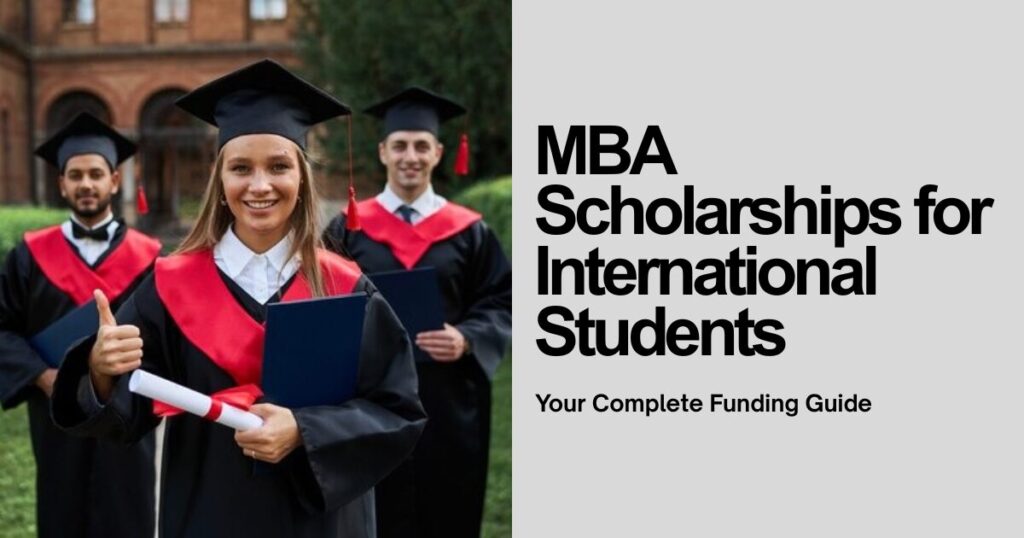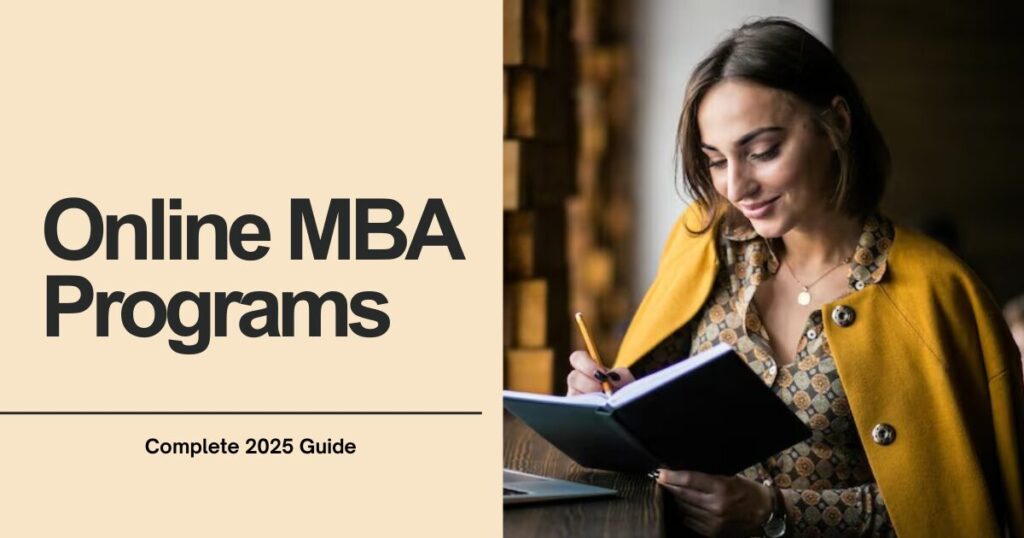
MBA scholarships for international students are financial awards covering tuition, fees, and living expenses at business schools worldwide. Top programs like Harvard Business School, Stanford GSB, and INSEAD offer merit-based and need-based scholarships ranging from $10,000 to full tuition. International students can access university-specific awards, external fellowships, and organization-sponsored programs by maintaining strong academic records and applying early.
An MBA degree can reshape your career trajectory. But let’s address the obvious challenge: the price tag. With tuition at top business schools exceeding $80,000 per year, international students face significant financial barriers. Here’s what many don’t realize—hundreds of scholarship programs exist specifically to support global talent pursuing MBA degrees.
This guide walks you through everything you need to know about securing MBA scholarships as an international student. You’ll discover specific programs, eligibility criteria, application strategies, and insider tips that can save you tens of thousands of dollars.
Understanding MBA Scholarships: What You Need to Know?
MBA scholarships come in different forms, each designed to address specific needs and reward particular achievements. Understanding these categories helps you target the right opportunities.
Merit-based scholarships recognize academic excellence, leadership potential, and professional achievements. Most business schools automatically consider admitted students for these awards based on their application strength. Your GMAT or GRE scores, undergraduate GPA, work experience, and leadership roles significantly influence these decisions. Schools like Wharton and Kellogg distribute substantial merit awards to attract top candidates.
Need-based scholarships focus on your financial circumstances rather than just achievements. Harvard Business School and Stanford Graduate School of Business operate primarily on this model. These programs evaluate your family income, assets, and undergraduate debt to determine funding levels. Approximately 50% of students at these institutions receive financial aid, with some qualifying for full tuition coverage.
Diversity and inclusion scholarships aim to create balanced cohorts representing various backgrounds, industries, and regions. The Forté Foundation supports women in MBA programs through partnerships with leading business schools. The Consortium for Graduate Study in Management offers full-tuition fellowships to underrepresented minorities. These programs recognize that diverse perspectives strengthen business education and organizational effectiveness.
The application process varies by scholarship type. Merit-based awards typically require no additional application—admission committees evaluate your regular MBA application materials. Need-based scholarships demand detailed financial documentation, including tax returns and bank statements. External fellowships often involve separate applications with unique essays and recommendation requirements.
Top MBA Scholarship Programs for International Students
Several prestigious programs specifically welcome international applicants, offering substantial financial support.
MPOWER Financing MBA Scholarship provides up to $10,000 to international students pursuing MBAs at eligible schools across the United States and Canada. You don’t need to be an MPOWER borrower to apply. The program awards three scholarships annually: first place receives $5,000, with additional awards of $2,000 and $1,000. Winners come from diverse backgrounds, attending institutions like NYU Stern and Queen’s University.
Oxford Pershing Square Graduate Scholarship offers one of the most comprehensive funding packages available. Six fully-funded positions cover both a master’s degree and MBA year at Oxford University through their 1+1 MBA program. This scholarship removes all financial barriers, covering tuition, college fees, and living expenses. Recipients join a tight-knit community of scholars committed to addressing world-scale challenges.
Knight-Hennessy Scholars Program at Stanford provides full funding for graduate study, including MBA programs. This highly competitive program selects candidates who demonstrate independence of thought, purposeful leadership, and civic mindedness. The scholarship covers tuition, stipend, and additional funds for academic expenses. Scholars become part of a multidisciplinary community across all Stanford graduate schools.
INSEAD scholarships for women include multiple endowed awards supporting female MBA candidates. The INSEAD Groupe Galeries Lafayette scholarship and similar programs particularly encourage applications from women in developing countries. These awards recognize the importance of increasing women’s representation in leadership roles globally. Application essays typically focus on workplace diversity and inclusion topics.
The Boustany MBA Harvard Scholarship appears once every two years, covering 75% of tuition fees for Harvard Business School students. Priority goes to candidates of Lebanese descent, though applicants from any nation can apply. Recipients complete a two-month internship with the Boustany Foundation in Monaco, gaining additional international experience while contributing to the foundation’s mission.
Business schools themselves offer numerous scholarships. Kellogg School of Management distributes dozens of merit and need-based awards, some including mentorship opportunities. Columbia Business School provides partial-tuition scholarships ranging from $10,000 to $30,000 for qualified candidates. NYU Stern offers specialized fellowships targeting specific industries and career paths.
People Also Love to Read This: Online MBA Programs: Complete 2025 Guide
Eligibility Requirements: What Scholarship Committees Look For?
Scholarship committees evaluate multiple factors when selecting recipients. Understanding these criteria helps you strengthen your application.
Academic performance serves as a foundation. Most programs require minimum GPAs, typically 3.0 or higher for competitive consideration. Your GMAT or GRE scores carry significant weight, especially for merit-based awards. Data shows applicants with GMAT scores above 730 receive substantially larger scholarship offers than those with lower scores. These standardized tests provide committees with comparable metrics across diverse educational systems.
Professional experience matters beyond just years worked. Committees assess the quality of your career progression, leadership responsibilities, and impact within organizations. They look for candidates who’ve demonstrated initiative, solved complex problems, and influenced others. Your career trajectory should show upward momentum and increasing responsibility.
Leadership extends beyond formal titles. Scholarship evaluators seek evidence of community involvement, extracurricular activities, and volunteer commitments. These experiences reveal your values, interpersonal skills, and ability to effect change outside professional contexts. International students who’ve contributed to their communities while managing cultural and language challenges often stand out.
The diversity factor plays a crucial role. Business schools value students who bring unique perspectives based on their geographic origin, industry background, or life experiences. As an international student, your cross-cultural competencies and global viewpoint become assets. Committees want to understand how your presence will enrich classroom discussions and peer learning.
Financial need varies in importance depending on the scholarship type. Need-based programs require detailed documentation of your family’s financial situation, including income statements, asset declarations, and dependent information. Schools use standardized formulas to ensure fair comparisons across different economic contexts and currency systems.
Some scholarships target specific demographics or career interests. The Reaching Out LGBTQ MBA Fellowship supports students demonstrating leadership within the LGBTQ+ community. The TY Danjuma MBA Scholarship specifically assists African students admitted to top-10 business schools as ranked by the Financial Times. Research programs aligning with your background and goals.
Strategic Application Tips to Maximize Your Chances
Winning scholarships requires more than meeting basic requirements. Strategic preparation significantly improves your success rate.
Start early—really early. Most business schools operate on rolling admissions with multiple application rounds. Round 1 deadlines typically fall in September or October, with Round 2 in January. Here’s the reality: scholarship funds deplete as the admissions cycle progresses. Schools reserve their largest awards for early applicants, ensuring they can attract their most desired candidates. By Round 3, far less money remains available. If scholarships are crucial to your MBA plans, target Round 1 or early Round 2 deadlines.
Maximize your test scores. If you took the GMAT or GRE just once or twice with minimal preparation, consider investing in additional study time or tutoring. Each 10-point increase in your GMAT score can translate to thousands of dollars in scholarship money. Schools use these scores for both admissions decisions and scholarship allocations. They also factor into business school rankings, making high-scoring students particularly attractive to programs.
Craft a compelling narrative. Your application should tell a coherent story about who you are, where you’re heading, and why this particular MBA program fits your journey. Scholarship committees fund candidates who demonstrate clear purpose and authentic motivation. Avoid generic statements about wanting to “make a difference” or “become a leader.” Instead, provide specific examples of problems you’ve solved, challenges you’ve overcome, and goals you’re pursuing.
Demonstrate genuine interest. Schools want assurance that scholarship recipients will actually enroll. Attend information sessions, connect with current students and alumni, and visit campus if possible. These interactions show commitment while helping you gather insights for more compelling essays. Some applicants even reference specific professors, programs, or resources they’re excited about in their applications.
Apply to multiple programs. This strategy serves two purposes. First, it increases your overall chances of receiving scholarship offers. Second, it creates negotiation leverage. If a peer institution offers you better funding, your top-choice school may increase their package to secure your enrollment. Schools compete for talented international students, and scholarship negotiation is more common than many applicants realize.
Polish every detail. Scholarship committees review countless applications. Small mistakes or careless errors suggest a lack of seriousness. Have multiple people review your essays, check for grammatical errors, and ensure all required materials are submitted correctly. Strong recommendation letters from supervisors who know your work deeply carry more weight than generic endorsements from high-ranking executives.
Research external opportunities. Beyond school-specific awards, numerous organizations offer MBA scholarships to international students. The Fulbright Program supports students from over 160 countries. Corporate-sponsored scholarships from companies like BMW Group provide funding while potentially opening career opportunities. Professional associations related to your industry often maintain scholarship programs for graduate students.
Complete the FAFSA if eligible. While primarily designed for U.S. citizens, some schools accept the Free Application for Federal Student Aid from international students to assess need-based aid eligibility. Even if not required, submitting financial documentation early demonstrates your serious intent and helps schools understand your circumstances.
Common Mistakes International Students Should Avoid
Understanding pitfalls helps you sidestep obstacles that derail otherwise strong candidates.
The biggest mistake? Waiting too long to apply. International students face additional complexities including visa processing, credential evaluations, and document translations. These logistics take time. Missing early deadlines not only reduces scholarship opportunities but may also limit your admission chances entirely.
Another error involves inadequate research. Applying to programs that don’t align with your career goals or values wastes both your time and application fees. Each MBA program has a distinct culture, pedagogical approach, and industry connections. Shotgun applications rarely succeed—targeted, well-researched applications perform significantly better.
Many international applicants underestimate their value. Your global perspective, multilingual abilities, and cross-cultural experiences represent significant assets. Don’t apologize for language imperfections or try to minimize your international background. Instead, showcase how these elements make you uniquely valuable to incoming cohorts.
Weak essays sink applications. Generic statements about leadership or vague career goals fail to differentiate you. Scholarship committees read thousands of essays. Yours needs specific details, authentic voice, and clear connections between your experiences and future plans. Show rather than tell—use concrete examples to illustrate your points.
Neglecting to follow instructions seems obvious but happens frequently. Each scholarship may have specific essay prompts, word limits, or required documents. Submitting incomplete applications or ignoring guidelines signals carelessness and disqualifies you from consideration.
Finally, many students overlook smaller scholarships, focusing only on full-tuition awards. Partial scholarships of $10,000 to $25,000 significantly reduce your financial burden. You can often combine multiple smaller awards to cover substantial portions of your costs. Don’t dismiss opportunities because they don’t cover everything.
People Also Love to Read This: Best Student Loan Providers: 2025 Complete Guide
Planning Your MBA Funding Strategy
A comprehensive funding approach combines multiple sources rather than relying on a single scholarship.
Start by calculating your total cost of attendance, including tuition, living expenses, health insurance, books, and travel. International students often face higher costs due to visa fees and less access to part-time employment. Understanding the complete picture helps you set realistic funding goals.
Build a diversified funding portfolio. This might include school-based scholarships, external fellowships, personal savings, family contributions, and student loans. International student loans are available from lenders like MPOWER Financing and Prodigy Finance, specifically designed for students studying abroad without U.S. cosigners.
Consider employer sponsorship if you’re currently employed. Some companies will partially or fully fund MBA education in exchange for a post-graduation work commitment. This arrangement reduces your debt burden while potentially preserving your job security. Review your employment contract and discuss options with your supervisor.
Timeline matters enormously. Begin researching scholarship opportunities at least 18 months before your intended start date. This gives you adequate time to prepare for standardized tests, gather recommendation letters, and craft thoughtful applications. Create a spreadsheet tracking deadlines, requirements, and application statuses for each opportunity.
Don’t forget about second-year funding. Some scholarships become available after you’ve completed your first year of MBA study. Maintain strong grades and continue engaging with scholarship offices throughout your program. Additional funding opportunities may emerge based on your academic performance or specific research interests.
Frequently Asked Questions
Can I combine multiple MBA scholarships to cover my full tuition?
Yes, most schools allow students to combine various scholarship awards unless specific terms prohibit it. You can typically stack university scholarships with external fellowships and organization-specific grants. However, always review each scholarship’s terms and conditions carefully. Some awards reduce proportionally if you receive additional funding, while others maintain their full value. Schools want you to attend with minimal financial stress, so combining awards is generally encouraged. Just keep the financial aid office informed about all funding sources you receive.
What if English is not my first language—will this hurt my scholarship chances?
Not at all. Business schools actively seek international students who bring diverse perspectives and global viewpoints. Your English proficiency needs to meet minimum requirements for admission (usually demonstrated through TOEFL or IELTS scores), but committees understand that non-native speakers may express themselves differently. Focus on clear, authentic communication rather than perfect grammar. Many successful scholarship recipients are non-native English speakers who effectively conveyed their stories and potential. Your unique background often enhances rather than hinders your application.
How competitive are MBA scholarships for international students really?
Competition varies significantly by program and scholarship type. Top schools like Harvard and Stanford admit only a small percentage of applicants, but approximately 50% of admitted students receive some financial aid. Merit-based scholarships depend heavily on your profile relative to other applicants—strong GMAT scores, unique experiences, and compelling essays dramatically improve your odds. Need-based scholarships focus more on demonstrated financial circumstances. External fellowships targeting specific demographics or regions may face less competition than general awards. Apply strategically to programs where your profile aligns strongly with their student body goals.










